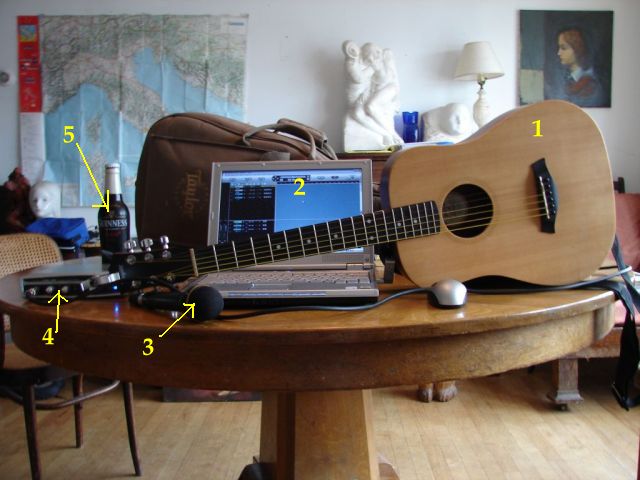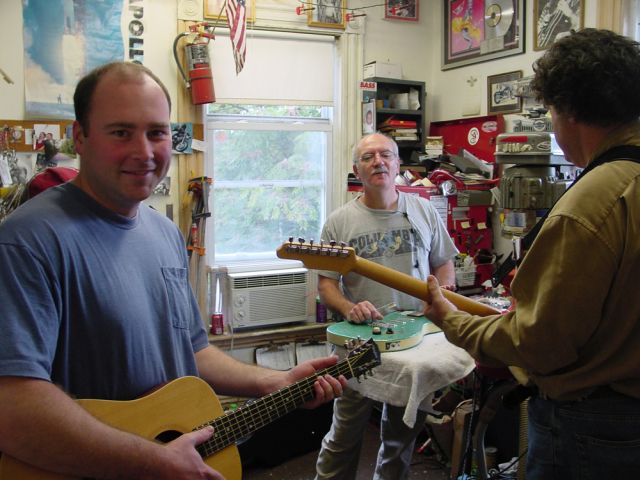I present to you what I hope will be the bare minimum necessary to create representative recordings of road-written songs, arranged as a still life in the style of the impressionist masters of bygone days.
The important considerations were size and sound quality. Expense was also considered carefully, but I tried not to settle for cheap crap. This setup is by no means expected to give studio-quality sound, but it's not bad for a kit that will be lugged all over kingdom-come.
See below for a description of each component. And of course stay tuned for some road recordings, so you can judge the quality for yourself.

1. This is my baby. I mean, my Baby.
It's a Baby Taylor, what I consider to be the finest of the myriad travel-size guitars. It's not quite as small as, for example, a Martin Backpacker, but it is infinitely more playable and better sounding. I installed a Fishman Matrix II pickup in this one, as you can tell by the chord dangling from the end. The on-stage sound quality of this half-quart-size piece of equipment with that sweet pickup is something to behold. For certain styles of music, I prefer it to a full-size dreadnought.
2. My Dell XPS M1210 laptop.
This baby sports a 12" screen, dual-core processors, a gig of RAM, and a whole lot of sexy computing power. First thing I did when I got the computer was to re-format the hard drive and install Windows XP from scratch on one partition, and SimplyMepis Linux on another. If you're going to do that, make sure you get all the install disks from Dell, because they sometimes cheap out on that aspect.
On the screen you can see Cakewalk Sonar Home Studio Edition. I tried a few free or budget multitrack recording software solutions, but none could compare to the stability and useability of this old standby. And at $149, the Home Studio Edition is not a bad deal.
3. The microphone.
Whether you call it a mic or a mike or a doohicky, it's the most essential part of any recording setup. It's the first place the sound hits, so you want to make sure it doesn't get messed up right there. This one is an Electrovoice ND767. It's a great workman-like piece of equipment that will hold up to the stress of travelling, and I think gives a great color to my voice. You wouldn't want to take a condenser microphone on a six-month jaunt. Stick to capacitor mikes, or neodyminium, which this one is.
4. M-Audio MobilePre USB.
The audio interface. It takes two inputs, either microphone or line level, has a built-in mike pre-amp and phantom power. I tried recording directly into my laptop's line input, but the signal was so weak and noisy I decided to try something more advanced. I'll let you know how it turns out.
5. Inspiration.
What, you didn't think I wrote these songs sober, did you?
Postscript
Looking at the above meticulously arranged still life, you may be thinking, "Wow, Eddy Boston sure knows how to arrange guitars and stuff on a kitchen table." Or you may be thinking, "Gee, that guitar looks like it's about to fall."
If you were thinking the latter, you were right.
Minutes after the picture was taken, as I was lifting the pictures from the camera onto the computer, I heard from the other room a heartbreaking series of sounds:
Rattle!
Crash!
"Oh, shit!"
I immediately closed my eyes. I knew exactly what the sound meant, but wanted to enjoy a few seconds of denial before the visual confirmation. My father, in coming to see the photograph in all it's LCD-enhanced glory on the computer screen, brushed the kitchen table ever so slightly, disturbing my Baby's precarious equilibrium.
With less than ten hours before I was scheduled to leave home for the life of a wandering minstrel, my traveling instrument had a chunk of wood broken off the sound board, and another section splintered painfully.
I immediately went into crisis mode. Much like Tom Brady in the final minutes of a crucial game, I thrive under pressure. The one mistake I made was in failing to take a picture of the broken guitar for documentation purposes, so I can't show you exactly how traumatizing it was. Time, however, was of the essense, and I was wasting none. I got on the phone and started calling every reputable guitar repair man I knew. Miraculously, one came through. With overbooked schedules and difficult work conditions, it's hard to expect any such tradesman to bend over backwards for a desparate musician he doesn't even know. Nevertheless, I made my departure on time, and Jim Mouradian, of Mouradian Guitar, 1904 Massachusetts Ave, Cambridge, MA, has earned a loyal customer for life.

Pictured: Eddy Boston with his newly-repaired Baby Taylor, Jim Mouradian working on his next big repair, and an unknown rock-star jamming on a vintage Strat.


